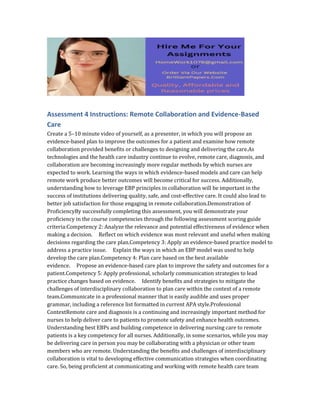
Assessment 4 Remote Collaboration and Care.docx
- 1. Assessment 4 Instructions: Remote Collaboration and Evidence-Based Care Create a 5–10 minute video of yourself, as a presenter, in which you will propose an evidence-based plan to improve the outcomes for a patient and examine how remote collaboration provided benefits or challenges to designing and delivering the care.As technologies and the health care industry continue to evolve, remote care, diagnosis, and collaboration are becoming increasingly more regular methods by which nurses are expected to work. Learning the ways in which evidence-based models and care can help remote work produce better outcomes will become critical for success. Additionally, understanding how to leverage EBP principles in collaboration will be important in the success of institutions delivering quality, safe, and cost-effective care. It could also lead to better job satisfaction for those engaging in remote collaboration.Demonstration of ProficiencyBy successfully completing this assessment, you will demonstrate your proficiency in the course competencies through the following assessment scoring guide criteria:Competency 2: Analyze the relevance and potential effectiveness of evidence when making a decision. Reflect on which evidence was most relevant and useful when making decisions regarding the care plan.Competency 3: Apply an evidence-based practice model to address a practice issue. Explain the ways in which an EBP model was used to help develop the care plan.Competency 4: Plan care based on the best available evidence. Propose an evidence-based care plan to improve the safety and outcomes for a patient.Competency 5: Apply professional, scholarly communication strategies to lead practice changes based on evidence. Identify benefits and strategies to mitigate the challenges of interdisciplinary collaboration to plan care within the context of a remote team.Communicate in a professional manner that is easily audible and uses proper grammar, including a reference list formatted in current APA style.Professional ContextRemote care and diagnosis is a continuing and increasingly important method for nurses to help deliver care to patients to promote safety and enhance health outcomes. Understanding best EBPs and building competence in delivering nursing care to remote patients is a key competency for all nurses. Additionally, in some scenarios, while you may be delivering care in person you may be collaborating with a physician or other team members who are remote. Understanding the benefits and challenges of interdisciplinary collaboration is vital to developing effective communication strategies when coordinating care. So, being proficient at communicating and working with remote health care team
- 2. members is also critical to delivering quality, evidence-base care.ScenarioThe Vila Health: Remote Collaboration on Evidence-Based Care simulation provide the context for this assessment.InstructionsBefore beginning this assessment, make sure you have worked through the following media:Vila Health: Remote Collaboration on Evidence-Based Care. For this assessment, you are a presenter! You will create a 5–10-minute video using Kaltura or similar software. In the video:Propose an evidence-based care plan that you believe will improve the safety and outcomes of the patient in the Vila Health Remote Collaboration on Evidence-Based Care media scenario.Discuss the ways in which an EBP model and relevant evidence helped you to develop and make decision about the plan you proposedWrap up your video by identifying the benefits of the remote collaboration in the scenario, as well as discuss strategies you found in the literature or best practices that could help mitigate or overcome one or more of the collaboration challenges you observed in the scenario.Be sure you mention any articles, authors, and other relevant sources of evidence that helped inform your video. Important: You are required to submit an APA-formatted reference list of the sources you cited specifically in your video or used to inform your presentation. The following media is an example learner submission in which the speaker successfully addresses all competencies in the assessment.Exemplar Kaltura Reflection. Please note that the scenario that the speaker discusses in the exemplar is different from the Vila Health scenario you should be addressing in your video. So, the type of communication expected is being model, but the details related to the scenario in your submission will be different.Make sure that your video addresses the following grading criteria:Propose an evidence-based care plan to improve the safety and outcomes for a patient based on the Vila Health Remote Collaboration on Evidence-Care media scenario.Explain the ways in which an EBP model was used to help develop the care plan.Reflect on which evidence was most relevant and useful when making decisions regarding the care plan.Identify benefits and strategies to mitigate the challenges of interdisciplinary collaboration to plan care within the context of a remote team.Communicate in a professional manner that is easily audible and uses proper grammar, including a reference list formatted in current APA style.Refer to Using Kaltura [PDF] as needed to record and upload your video.Note: If you require the use of assistive technology or alternative communication methods to participate in this activity, please contact DisabilityServices@Capella.edu to request accommodations. If, for some reason, you are unable to record a video, please contact your faculty member as soon as possible to explore options for completing the assessment.Additional RequirementsYour assessment should meet the following requirements:Length of video: 5–10 minutes.References: Cite at least three professional or scholarly sources of evidence to support the assertions you make in your video. Include additional properly cited references as necessary to support your statements.APA reference page: Submit a correctly formatted APA reference page that shows all the sources you used to create and deliver your video. Be sure to format the reference page according to current APA style.